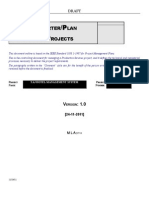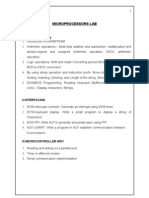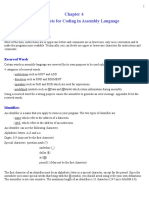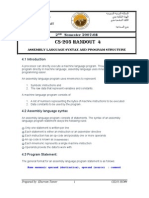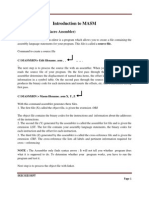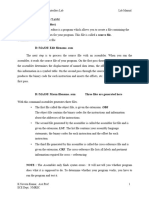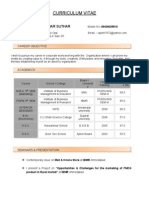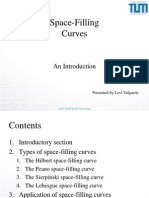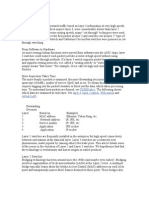Mm
Mm
Uploaded by
surjeetkumari1974Copyright:
Available Formats
Mm
Mm
Uploaded by
surjeetkumari1974Copyright
Available Formats
Share this document
Did you find this document useful?
Is this content inappropriate?
Copyright:
Available Formats
Mm
Mm
Uploaded by
surjeetkumari1974Copyright:
Available Formats
ROHINI COLLEGE OF ENGINEERING & TECHNOLOGY
1.4 ASSEMBLER DIRECTIVES
Assembler directives help the assembler to correctly understand the
assembly language programs to prepare the codes. Another type of hint which
helps the assembler to assign a particular constant with a label or initialize
particular memory locations or labels with constants is called an operator. Rather,
the operators perform the arithmetic and logical tasks unlike directives that just
direct the assembler to correctly interpret the program to code it appropriately. The
following directives are commonly used in the assembly language programming
practice using Microsoft Macro Assembler (MASM) or Turbo Assembler
(TASM).
DB: Define Byte
The DB directive is used to reserve byte or bytes of
memory locations in the available memory.
LIST DB 0lH, 02H, 03H, 04H
This statement directs the assembler to reserve four memory locations for a list
named LIST and initialize them with the above specified four values.
DW: Define Word
It makes the assembler reserve the number of memory words (16-bit) instead
of bytes. Some examples are given to explain this directive.
Examples WORDS DW 1234H, 4567H, 78ABH, 045CH
DQ: Define Quad word
This directive is used to direct the assembler to reset 4words (8
bytes) of memory for the specified variable and may initialize it with the specified
values.
DT: Define Ten Bytes
The DT directive directs the assembler to define the specified
variable requiring l -bytes for its storage and initialize the 10bytes with the
specified values.
EC8691 MICROPROCESSORS AND MICROCONTROLLERS
ROHINI COLLEGE OF ENGINEERING & TECHNOLOGY
ASSUME: Assume Logical Segment Name
The ASSUME directive is used to inform the assembler, the names
of the logical segments to be assumed for different segments used in the program.
In the assembly language program, each segment is given aname.
For example, the code segment may be given the name CODE, data
segment may be given the name DATA etc.
ASSUME CS:
CODE directs the assembler that the machine codes are available
in a segment named CODE, and hence the CS register is to be loaded with the
Address(segment) allotted by the operating system for the label CODE, while
loading.
ASSUME DS:
DATA indicates to the assembler that the data items related to
the program, are available in a logical segment named DATA, and the DS
register is to be initialized by the segment Address value decided by the
operating system for the data segment, while loading.
END: END of Program
The END directive marks the end of an assembly language
program. When the assembler comes across this END directive, it ignores the
source lines available later on. Hence, it should be ensured that the END statement
should be the last statement in the file and should not appear in between.
ENDP: END of Procedure.
In assembly language programming, the subroutines are called
procedures. Thus, procedures may be independent program modules which
return particular results or values to the calling programs. The ENDP directive
is used to indicate the end of a procedure.
PROCEDURE STAR
.
.
STAR ENDP
EC8691 MICROPROCESSORS AND MICROCONTROLLERS
ROHINI COLLEGE OF ENGINEERING & TECHNOLOGY
ENDS: END of Segment
This directive marks the end of a logical segment.
DATA SEGMENT
.
.
.
DATA ENDS
ASSUME CS: CODE, DS:DATA CODE SEGMENT.
.
.
.
C
O
D
E
E
N
D
S
E
N
D
The above structure represents a simple program containing two segments
named DATA and CODE. The data related to the program must lie between the
DATA SEGMENT and DATA ENDS statements. Similarly, all the executable
instructions must lie between CODE SEGMENT and CODE ENDS statements.
EVEN: Align on Even Memory Address
The EVEN directive updates the location counter to the next even
Address if the current location counter contents are not even, and assigns the
following routine or variable or constant to that Address.
EC8691 MICROPROCESSORS AND MICROCONTROLLERS
ROHINI COLLEGE OF ENGINEERING & TECHNOLOGY
EQU: Equate
The directive EQU is used to assign a label with a value or a
symbol. The use of this directive is just to reduce the recurrence of the numerical
values or constants in a program code.
Example
LABEL
EQU
0500H
ADDITI
ON EQU
ADD
The first statement assigns the constant 500H with the label LABEL, while the
second statement assigns another label ADDITION with mnemonic ADD.
EXTRN: External and Public
The directive EXTRN informs the assembler that the names,
procedures and labels declared after this directive have already been defined in
some other assembly language modules.
GROUP: Group the Related segment
The directive is used to form logical groups of segments with
similar purpose or type. This directive is used to inform the assembler to form a
logical group of the following segment names.
PROGRAM GROUP CODE, DATA, STACK
The above statement directs the loader/linker to prepare an EXE file such
that CODE, DATA and STACK segment must lie within a 64kbyte memory
segment that is named as PROGRAM. Now, for the ASSUME statement, one can
use the label PROGRAM rather than CODE, DATA and STACK as shown.
ASSUME CS: PROGRAM, DS: PROGRAM, SS: PROGRAM.
LABEL: Label
The Label directive is used to assign a name to the current content
of the location counter. At the start of the assembly process, the assembler
EC8691 MICROPROCESSORS AND MICROCONTROLLERS
ROHINI COLLEGE OF ENGINEERING & TECHNOLOGY
initializes a location counter to keep track of memory locations assigned to the
program.
LENGTH: Byte Length of a Label
This directive is not available in MASM. This is used to refer
to the length of a data array or a string.
MOV CX, LENGTH ARRAY
LOCAL:
The labels, variables, constants or procedures declared LOCAL
in a module are to be used only by thatmodule.
NAME: Logical Name of a Module
The NAME directive is used to assign a name to an assembly
language program module. The module may now be referred to by its declared
name.
OFFSET: Offset of a Label
When the assembler comes across the OFFSET operator along with a
label, it first computes the 16-bit displacement (also called as offset
interchangeably) of the particular label, and replaces the string 'OFFSET LABEL'
by the computed displacement.
ORG: Origin
The ORG directive directs the assembler to start the memory
allotment for the particular segment, block or code from the declared Addressing.
The ORG statement while starting the assembly process for a module, the
assembler initializes a location counter to keep track of the allotted addresses for
the module. If the ORG statement is not written in the program, the location counter
is initialized to 0000. If an ORG 200H statement is present at the starting of the
code segment of that module, then the code will start from 200H Addressing code
segment.
PROC: Procedure
The PROC directive marks the start of a named procedure in the
statement.
EC8691 MICROPROCESSORS AND MICROCONTROLLERS
ROHINI COLLEGE OF ENGINEERING & TECHNOLOGY
PTR: Pointer
The pointer operator is used to declare the type of a label, variable
or memory operand. The operator PTR is prefixed by either BYTE or WORD. If
the prefix is BYTE, then the particular label, variable or memory operand is treated
as an 8-bit quuantitywhile if WORD is the prefix, then it is treated as a 16- bit quantity.
Example:
MOV AL, BYTE PTR [SI];
Moves content of memory location addressed by SI (8-bit) to AL
SEG: Segment of a Label
The SEG operator is used to decide the segment Address of the label,
variable, or procedure and substitutes the segment base Address in place of ‘SEG
label’. The example given below explains the use of SEG operator.
Example MOV AX, SEG ARRAY;
This statement moves the segment address
SEGMENT: Logical Segment
The SEGMENT directive marks the starting of a logical segment.
The started segment is also assigned a name, i.e. label, by this statement. The
SEGMENT and ENDS directive must bracket each logical segment of a
program.
TYPE :
The TYPE operator directs the assembler to decide the data type
of the specified label and replaces the 'TYPE label' by the decided data type.
For the word type variable, the data type is 2, for double word type, it is 4, and
for byte type, it is 1.
GLOBAL:
The labels, variables, constants or procedures declared
GLOBAL may be used by other modules of the program. Once a variable is
declared GLOBAL, it can be used by any module in the program. The
following statement declares the procedure ROUTINE as a global label.
EC8691 MICROPROCESSORS AND MICROCONTROLLERS
ROHINI COLLEGE OF ENGINEERING & TECHNOLOGY
EC8691 MICROPROCESSORS AND MICROCONTROLLERS
You might also like
- Assembly Programming:Simple, Short, And Straightforward Way Of Learning Assembly LanguageFrom EverandAssembly Programming:Simple, Short, And Straightforward Way Of Learning Assembly LanguageRating: 5 out of 5 stars5/5 (2)
- IEEE Project CharterDocument16 pagesIEEE Project CharterDoondi KalyanNo ratings yet
- International GatewayDocument4 pagesInternational GatewayPallab SarwarNo ratings yet
- Coffee Shop Management System C#Document43 pagesCoffee Shop Management System C#abhi61% (31)
- T Distribution Critical Values TableDocument6 pagesT Distribution Critical Values TableTrần Vĩnh Cửu0% (1)
- Piping Specialty Item Design GuideDocument3 pagesPiping Specialty Item Design GuideCivil Friend67% (3)
- Pandapower PDFDocument167 pagesPandapower PDFAlen TatalovićNo ratings yet
- Assembler Directives 8086Document18 pagesAssembler Directives 8086Jasmine KNo ratings yet
- Assembler Directives and Basic Steps of ALP: Dr. Urvashi SinghDocument20 pagesAssembler Directives and Basic Steps of ALP: Dr. Urvashi SinghbeaulajenishNo ratings yet
- Assembler Directives and OperatorsDocument6 pagesAssembler Directives and Operatorsvijaykannamalla100% (1)
- Assembler:: Procedure For Assembling A ProgramDocument12 pagesAssembler:: Procedure For Assembling A ProgramAilin Maria LopezNo ratings yet
- Assembler DirectivesDocument5 pagesAssembler DirectivesTHIYAGARAJANNo ratings yet
- MPMC LAB Manual R20-1Document50 pagesMPMC LAB Manual R20-1bmn889735No ratings yet
- Chapter 7: Assembler Directives and Data Definitions: CsectDocument16 pagesChapter 7: Assembler Directives and Data Definitions: CsectSiranjeevi MohanarajaNo ratings yet
- Notes - Assembler DirectivesDocument23 pagesNotes - Assembler DirectivesghangaleNo ratings yet
- Lecture 6 Assembly Language Programming - IntroductionDocument4 pagesLecture 6 Assembly Language Programming - Introductionodero4029No ratings yet
- Assembler DirectivesDocument29 pagesAssembler DirectivesMurali KrishnaNo ratings yet
- Assembler DirectivesDocument7 pagesAssembler DirectivesChalo NdikoNo ratings yet
- Directives DDDocument19 pagesDirectives DDtariku fkaduNo ratings yet
- Lesson No 2 MICDocument12 pagesLesson No 2 MICproguy0103No ratings yet
- MPMC LAB Manual R20Document49 pagesMPMC LAB Manual R20vasudevanandhasrividya16No ratings yet
- Microprocessor Lab ManualDocument74 pagesMicroprocessor Lab ManualDhiraj IppiliNo ratings yet
- Topic 4:the Art of Assembly Language Programming (08 Marks)Document9 pagesTopic 4:the Art of Assembly Language Programming (08 Marks)cwipediaNo ratings yet
- Assembler Directives Micro Processors 8086Document4 pagesAssembler Directives Micro Processors 8086StephenKarunakarNo ratings yet
- CHAPTER 4 RoboticsDocument78 pagesCHAPTER 4 RoboticsRANDOMNo ratings yet
- Assembler Directives of 8086Document14 pagesAssembler Directives of 8086Yangannagari VineelareddyNo ratings yet
- Unit 2Document29 pagesUnit 2P KNo ratings yet
- FALLSEM2020-21 CSE2006 ETH VL2020210106464 Reference Material I 29-Jul-2020 MP-7 PDFDocument16 pagesFALLSEM2020-21 CSE2006 ETH VL2020210106464 Reference Material I 29-Jul-2020 MP-7 PDFNavya VermaNo ratings yet
- 8051 DirectivesDocument6 pages8051 DirectivesNaga ChaitanyaNo ratings yet
- Assemblers DirectivesDocument5 pagesAssemblers Directivesbmwau79No ratings yet
- Notes - Assembler Directives PDFDocument23 pagesNotes - Assembler Directives PDFAshritha G100% (1)
- MPMC Unit IiDocument45 pagesMPMC Unit Iipavannatural143No ratings yet
- Microprocessor Systems: Dr. Mona SayedDocument15 pagesMicroprocessor Systems: Dr. Mona Sayedbatool.alsharif.7070No ratings yet
- Requirements For Coding in Assembly LanguageDocument7 pagesRequirements For Coding in Assembly LanguageMultiple Criteria DssNo ratings yet
- Chapter 4Document80 pagesChapter 4Tigabu YayaNo ratings yet
- Assembler Directives of 8085Document19 pagesAssembler Directives of 8085sureshgurujiNo ratings yet
- Prapti Gandhi Exp 1 60Document11 pagesPrapti Gandhi Exp 1 60praptigandhi14No ratings yet
- Manual MasmDocument5 pagesManual MasmAshok RachapalliNo ratings yet
- MPMC Unit-1-Part-B PDFDocument23 pagesMPMC Unit-1-Part-B PDFSasi BhushanNo ratings yet
- ShruthiDocument4 pagesShruthiayushkulkarniworkNo ratings yet
- Assembler Directives Rv01Document24 pagesAssembler Directives Rv01Kavya ShreeNo ratings yet
- Assembler DirectivesDocument11 pagesAssembler DirectivesSivaprasad Reddy100% (2)
- Lecture-36 Assembler DirectivesDocument10 pagesLecture-36 Assembler DirectivessandeepNo ratings yet
- Lecture 4 Assembly Language Syntax and Program StructureDocument10 pagesLecture 4 Assembly Language Syntax and Program Structureapi-3739389100% (7)
- Lec - 12 Assembler DirectivesDocument19 pagesLec - 12 Assembler DirectivesMUHAMMAD ABDULLAHNo ratings yet
- Assembly Language Program: Series of Statements Which Are Either Assembly Language Instructions or DirectivesDocument16 pagesAssembly Language Program: Series of Statements Which Are Either Assembly Language Instructions or DirectivesKulal SwapnilNo ratings yet
- 03 IntroAssemblyDocument54 pages03 IntroAssemblym ansNo ratings yet
- Mpiprogram ManualDocument85 pagesMpiprogram ManualSukumar DasNo ratings yet
- qbDocument46 pagesqbumaubarathNo ratings yet
- 8086 Assembler Directives: SegmentDocument5 pages8086 Assembler Directives: SegmentNiharika KorukondaNo ratings yet
- Directives MacrosDocument16 pagesDirectives MacrosDr D S Naga Malleswara RaoNo ratings yet
- Interrupts, Memory Models & Simple InstructionsDocument7 pagesInterrupts, Memory Models & Simple InstructionsMuhammad Usman RafiqNo ratings yet
- Assembler: Is A Program That Accepts An Assembly Language Program As Input and Converts ItDocument25 pagesAssembler: Is A Program That Accepts An Assembly Language Program As Input and Converts ItAbdellah KafiNo ratings yet
- 2 The Art of Assembly Language ProgrammingDocument6 pages2 The Art of Assembly Language ProgrammingManofwarriorNo ratings yet
- Assembly Language AbDocument19 pagesAssembly Language AbseyfiNo ratings yet
- Assembly Language Programming: Bilal Zahoor Kashmir University North CampusDocument31 pagesAssembly Language Programming: Bilal Zahoor Kashmir University North CampusGunjan VermaNo ratings yet
- MPMC Lab Programs 2020-21Document59 pagesMPMC Lab Programs 2020-21ace4No ratings yet
- 3 Assembler DirectivesDocument73 pages3 Assembler Directivessharmaamit6059No ratings yet
- Assembler Directive in Microprocesser 8086Document18 pagesAssembler Directive in Microprocesser 8086Karan MoudgilNo ratings yet
- Assembler DirectivesDocument2 pagesAssembler DirectivesRashi RanaNo ratings yet
- DirectivesDocument11 pagesDirectivespancrace tardisNo ratings yet
- MPMC Lab - Expt1 Introduction To TasmDocument7 pagesMPMC Lab - Expt1 Introduction To Tasmsanti santillano100% (1)
- Practical Reverse Engineering: x86, x64, ARM, Windows Kernel, Reversing Tools, and ObfuscationFrom EverandPractical Reverse Engineering: x86, x64, ARM, Windows Kernel, Reversing Tools, and ObfuscationNo ratings yet
- MVS JCL Utilities Quick Reference, Third EditionFrom EverandMVS JCL Utilities Quick Reference, Third EditionRating: 5 out of 5 stars5/5 (1)
- Résumé of RajeshDocument2 pagesRésumé of Rajeshrajesh7672No ratings yet
- Veritas Storage Foundation™ and High Availability Solutions Getting Started GuideDocument14 pagesVeritas Storage Foundation™ and High Availability Solutions Getting Started GuideKumarRaviNo ratings yet
- Lecture 41 - Cloud Computing - PracticalDocument26 pagesLecture 41 - Cloud Computing - PracticalPraneetha InumarthiNo ratings yet
- Air Handling Unit Preventive Maintenance Checklist PDFDocument2 pagesAir Handling Unit Preventive Maintenance Checklist PDFAditya SuardiNo ratings yet
- Department of Electronics & Communcitionengineering: To Impart Knowledge On 2D DFT and Its PropertiesDocument5 pagesDepartment of Electronics & Communcitionengineering: To Impart Knowledge On 2D DFT and Its PropertiesrajNo ratings yet
- Plcopen Compliant Libraries v10Document89 pagesPlcopen Compliant Libraries v10erviranderNo ratings yet
- Objectives: Chapter 3: Feedback Control System CharacteristicsDocument17 pagesObjectives: Chapter 3: Feedback Control System CharacteristicsKota divyasreeNo ratings yet
- Pmu Communication And: Interface ManualDocument245 pagesPmu Communication And: Interface ManualSimon Bustamante CondoriNo ratings yet
- Peano Curves in FractalsDocument58 pagesPeano Curves in Fractalsnsavi16eduNo ratings yet
- No Layman Left Behind: Linear Algebra: What Matrices Actually AreDocument8 pagesNo Layman Left Behind: Linear Algebra: What Matrices Actually AreNeutronNo ratings yet
- XDLTSF Nflu K'/FG) Ah) 6nfo (LG/GT/TF-K - D E /fo (: JF/L SF/JFXLDF RF/ DLXGFD) NFV A9L /FHZJDocument4 pagesXDLTSF Nflu K'/FG) Ah) 6nfo (LG/GT/TF-K - D E /fo (: JF/L SF/JFXLDF RF/ DLXGFD) NFV A9L /FHZJmadheshpostNo ratings yet
- Database System Development LifecycleDocument19 pagesDatabase System Development LifecycleRabindra P.SinghNo ratings yet
- ER DiagramDocument16 pagesER DiagramGanesh KumarNo ratings yet
- Sbi Scholar Loan Scheme - List of Approved InstitutionsDocument6 pagesSbi Scholar Loan Scheme - List of Approved InstitutionscompangelNo ratings yet
- MCS024Document17 pagesMCS024Mr. Janardhana V ECENo ratings yet
- CISE301 Topic8L4&5Document36 pagesCISE301 Topic8L4&5Mohammad RameezNo ratings yet
- Capital Formboard XC 239252Document6 pagesCapital Formboard XC 239252nizarfebNo ratings yet
- TCP/IP Abc's Layer 3 Layer 2 Switch Web Switch Virtual LANDocument6 pagesTCP/IP Abc's Layer 3 Layer 2 Switch Web Switch Virtual LANapi-26278159No ratings yet
- PEPSI R2-Rollout and Back Out Plan - V1 2 - AD - HOC - LATAM - 4Document48 pagesPEPSI R2-Rollout and Back Out Plan - V1 2 - AD - HOC - LATAM - 4Satish R ChilkuryNo ratings yet
- MP250 / MP258 MP270 / MP276 MP490 / MP496 Service Reference ManualDocument5 pagesMP250 / MP258 MP270 / MP276 MP490 / MP496 Service Reference ManualelenoremailNo ratings yet
- Using Keypad - MC17.1Document4 pagesUsing Keypad - MC17.1Farty PantsNo ratings yet
- Evermotion Archmodels 77 PDFDocument2 pagesEvermotion Archmodels 77 PDFKennyNo ratings yet
- Cryptography and Network Security: Third Edition by William Stallings Lecture Slides by Lawrie BrownDocument38 pagesCryptography and Network Security: Third Edition by William Stallings Lecture Slides by Lawrie Brownsuyashdwivedi23No ratings yet
- JMapiDocument14 pagesJMapiPuspala ManojkumarNo ratings yet

